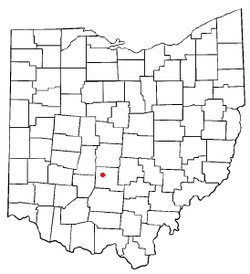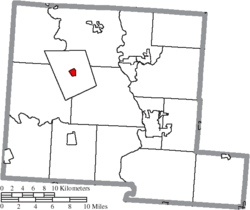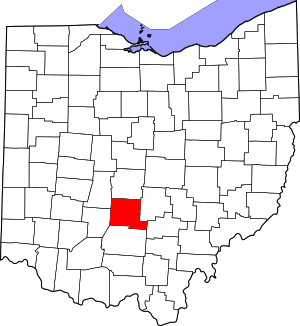Darbyville, Ohio
Darbyville is a village in Pickaway County, Ohio, United States. The population was 222 at the 2010 census.
Darbyville, Ohio | |
|---|---|
Looking east on Water Street (Ohio Highway 316) in Darbyville | |
 Location of Darbyville, Ohio | |
 Location of Darbyville in Pickaway County | |
| Coordinates: 39°41′44″N 83°6′46″W | |
| Country | United States |
| State | Ohio |
| County | Pickaway |
| Township | Muhlenberg |
| Area | |
| • Total | 0.54 sq mi (1.39 km2) |
| • Land | 0.52 sq mi (1.34 km2) |
| • Water | 0.02 sq mi (0.06 km2) |
| Elevation | 745 ft (227 m) |
| Population | |
| • Total | 222 |
| • Estimate (2019)[4] | 229 |
| • Density | 443.80/sq mi (171.42/km2) |
| Time zone | UTC-5 (Eastern (EST)) |
| • Summer (DST) | UTC-4 (EDT) |
| FIPS code | 39-20212[5] |
| GNIS feature ID | 1064507[2] |
History
Darbyville was laid out in 1826.[6] The village takes its name from nearby Little Darby Creek.[7]
Geography
Darbyville is located at 39°41′44″N 83°6′46″W (39.695622, -83.112768).[8]
According to the United States Census Bureau, the village has a total area of 0.49 square miles (1.27 km2), of which, 0.47 square miles (1.22 km2) is land and 0.02 square miles (0.05 km2) is water.[9]
Demographics
| Historical population | |||
|---|---|---|---|
| Census | Pop. | %± | |
| 1870 | 233 | — | |
| 1880 | 262 | 12.4% | |
| 1890 | 257 | −1.9% | |
| 1900 | 250 | −2.7% | |
| 1910 | 233 | −6.8% | |
| 1920 | 206 | −11.6% | |
| 1930 | 222 | 7.8% | |
| 1940 | 256 | 15.3% | |
| 1950 | 203 | −20.7% | |
| 1960 | 213 | 4.9% | |
| 1970 | 229 | 7.5% | |
| 1980 | 282 | 23.1% | |
| 1990 | 272 | −3.5% | |
| 2000 | 293 | 7.7% | |
| 2010 | 222 | −24.2% | |
| Est. 2019 | 229 | [4] | 3.2% |
| U.S. Decennial Census[10] | |||
2010 census
As of the census[3] of 2010, there were 222 people, 79 households, and 58 families living in the village. The population density was 472.3 inhabitants per square mile (182.4/km2). There were 92 housing units at an average density of 195.7 per square mile (75.6/km2). The racial makeup of the village was 98.2% White, 0.5% African American, and 1.4% from two or more races.
There were 79 households, of which 36.7% had children under the age of 18 living with them, 48.1% were married couples living together, 13.9% had a female householder with no husband present, 11.4% had a male householder with no wife present, and 26.6% were non-families. 22.8% of all households were made up of individuals, and 12.7% had someone living alone who was 65 years of age or older. The average household size was 2.81 and the average family size was 3.10.
The median age in the village was 38.4 years. 26.6% of residents were under the age of 18; 10% were between the ages of 18 and 24; 24.8% were from 25 to 44; 24% were from 45 to 64; and 14.9% were 65 years of age or older. The gender makeup of the village was 47.7% male and 52.3% female.
2000 census
As of the census[5] of 2000, there were 293 people, 94 households, and 75 families living in the village. The population density was 627.4 people per square mile (240.7/km2). There were 100 housing units at an average density of 214.1 per square mile (82.1/km2). The racial makeup of the village was 97.27% White. Hispanic or Latino of any race were 2.73% of the population.
There were 94 households, out of which 38.3% had children under the age of 18 living with them, 53.2% were married couples living together, 16.0% had a female householder with no husband present, and 20.2% were non-families. 17.0% of all households were made up of individuals, and 7.4% had someone living alone who was 65 years of age or older. The average household size was 3.12 and the average family size was 3.41.
In the village, the population was spread out, with 31.4% under the age of 18, 5.1% from 18 to 24, 32.1% from 25 to 44, 20.5% from 45 to 64, and 10.9% who were 65 years of age or older. The median age was 34 years. For every 100 females there were 104.9 males. For every 100 females age 18 and over, there were 93.3 males.
The median income for a household in the village was $37,727, and the median income for a family was $37,969. Males had a median income of $28,214 versus $20,000 for females. The per capita income for the village was $11,329. About 18.3% of families and 22.0% of the population were below the poverty line, including 25.9% of those under the age of eighteen and 25.0% of those 65 or over.
Gallery
- Darbyville corporation limit sign
References
- "2019 U.S. Gazetteer Files". United States Census Bureau. Retrieved July 27, 2020.
- "US Board on Geographic Names". United States Geological Survey. 2007-10-25. Retrieved 2008-01-31.
- "U.S. Census website". United States Census Bureau. Retrieved 2013-01-06.
- "Population and Housing Unit Estimates". United States Census Bureau. May 24, 2020. Retrieved May 27, 2020.
- "U.S. Census website". United States Census Bureau. Retrieved 2008-01-31.
- Kilbourn, John (1833). The Ohio Gazetteer, or, a Topographical Dictionary. Scott and Wright. pp. 172. Retrieved 12 December 2013.
- Overman, William Daniel (1958). Ohio Town Names. Akron, OH: Atlantic Press. p. 36.
- "US Gazetteer files: 2010, 2000, and 1990". United States Census Bureau. 2011-02-12. Retrieved 2011-04-23.
- "US Gazetteer files 2010". United States Census Bureau. Archived from the original on 2012-07-14. Retrieved 2013-01-06.
- "Census of Population and Housing". Census.gov. Retrieved June 4, 2015.
